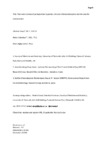The current status of perioperative hypnotics, the role of benzodiazepines and the case for remimazolam
| dc.contributor.author | Sneyd, John | |
| dc.contributor.author | Gambus, P | |
| dc.contributor.author | Rigby-Jones, A | |
| dc.date.accessioned | 2021-03-13T18:31:38Z | |
| dc.date.issued | 2021-05-06 | |
| dc.identifier.issn | 0007-0912 | |
| dc.identifier.issn | 1471-6771 | |
| dc.identifier.uri | http://hdl.handle.net/10026.1/16938 | |
| dc.description.abstract |
Anaesthesiologists and non-anaesthesiologist sedationists have a limited set of available i.v. hypnotics, further reduced by the withdrawal of thiopental in the USA and its near disappearance in Europe. Meanwhile, demand for sedation increases and new clinical groups are using what traditionally are anaesthesiologists' drugs. Improved understanding of the determinants of perioperative morbidity and mortality has spotlighted hypotension as a potent cause of patient harm, and practice must be adjusted to respect this. High-dose propofol sedation may be harmful, and a critical reappraisal of drug choices and doses is needed. The development of remimazolam, initially for procedural sedation, allows reconsideration of benzodiazepines as the hypnotic component of a general anaesthetic even if their characterisation as i.v. anaesthetics is questionable. Early data suggest that a combination of remimazolam and remifentanil can induce and maintain anaesthesia. Further work is needed to define use cases for this technique and to determine the impact on patient outcomes. | |
| dc.format.extent | 41-55 | |
| dc.format.medium | Print-Electronic | |
| dc.language | en | |
| dc.language.iso | en | |
| dc.publisher | Elsevier | |
| dc.subject | benzodiazepine | |
| dc.subject | hypnotic | |
| dc.subject | hypotension | |
| dc.subject | pharmacodynamics | |
| dc.subject | pharmacokinetics | |
| dc.subject | remimazolam | |
| dc.subject | sedation | |
| dc.title | The current status of perioperative hypnotics, the role of benzodiazepines and the case for remimazolam | |
| dc.type | journal-article | |
| dc.type | Journal Article | |
| dc.type | Review | |
| plymouth.author-url | https://www.webofscience.com/api/gateway?GWVersion=2&SrcApp=PARTNER_APP&SrcAuth=LinksAMR&KeyUT=WOS:000675498200021&DestLinkType=FullRecord&DestApp=ALL_WOS&UsrCustomerID=11bb513d99f797142bcfeffcc58ea008 | |
| plymouth.issue | 1 | |
| plymouth.volume | 127 | |
| plymouth.publication-status | Published | |
| plymouth.journal | British Journal of Anaesthesia | |
| dc.identifier.doi | 10.1016/j.bja.2021.03.028 | |
| plymouth.organisational-group | /Plymouth | |
| plymouth.organisational-group | /Plymouth/Faculty of Health | |
| plymouth.organisational-group | /Plymouth/Faculty of Health/Peninsula Medical School | |
| plymouth.organisational-group | /Plymouth/Research Groups | |
| plymouth.organisational-group | /Plymouth/Research Groups/Plymouth Institute of Health and Care Research (PIHR) | |
| plymouth.organisational-group | /Plymouth/Users by role | |
| plymouth.organisational-group | /Plymouth/Users by role/Academics | |
| dc.publisher.place | England | |
| dcterms.dateAccepted | 2021-03-10 | |
| dc.rights.embargodate | 2022-5-6 | |
| dc.identifier.eissn | 1471-6771 | |
| dc.rights.embargoperiod | Not known | |
| rioxxterms.versionofrecord | 10.1016/j.bja.2021.03.028 | |
| rioxxterms.licenseref.uri | http://www.rioxx.net/licenses/all-rights-reserved | |
| rioxxterms.licenseref.startdate | 2021-05-06 | |
| rioxxterms.type | Journal Article/Review |


